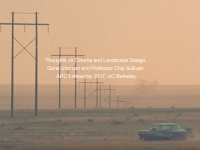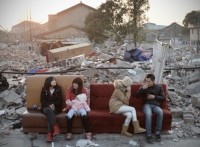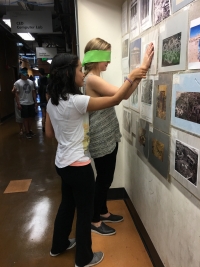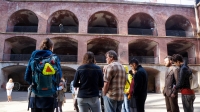Jiwon Chung Workshop: Theater of the Oppressed
Movement, Bodies, and Relationships of Power, Oppression, and Resistance
 Theater director Jiwon Chung recently led a Global Urban Humanities (GUH) workshop in which students considered systemic violence through a series of exercises based on the work of Augusto Boal. City and Regional Planning student Jeff Garnand, who participated in the workshop, reflects on how physical movement helped students from many disciplines consider power relationships.
Theater director Jiwon Chung recently led a Global Urban Humanities (GUH) workshop in which students considered systemic violence through a series of exercises based on the work of Augusto Boal. City and Regional Planning student Jeff Garnand, who participated in the workshop, reflects on how physical movement helped students from many disciplines consider power relationships.
Coursework in the humanities and social sciences often – should, must – bring students into contact with systems of oppression, hierarchy, and domination. And all students have had experience with these forms of power in their own lives in various institutional and social settings. Many have studied, and some have participated in, resistance movements that seek to challenge the exercise of power as a form of domination themselves. But how often are we provided with a forum in which to consider these manifestations through the methods of theater and performance?
The Global Urban Humanities program brought together students, faculty, and engaged members of the community for a workshop on considering systemic and structural violence, offering them the opportunity to work with Jiwon Chung, a theater practitioner and adjunct faculty member at the Graduate Theological Union with a long and deep connection with Augusto Boal’s Theater of the Oppressed.
Chun g uses Boal’s work as a way of helping students and communities recognize both the targeted and diffuse operation of oppression, and then using the format of movement, performance and theater as a generative space for conceiving forms of individual and collective resistance and counternarrative to advance social justice.
g uses Boal’s work as a way of helping students and communities recognize both the targeted and diffuse operation of oppression, and then using the format of movement, performance and theater as a generative space for conceiving forms of individual and collective resistance and counternarrative to advance social justice.
Workshop participants came from a range of fields in the arts, social sciences, environmental design, and humanities, bringing to the workshop their own disciplinary expertise and epistemologies. At the opening of the workshop, we were invited to meet each other, wandering the room loosely and encountering our fellow classmates and beginning to create webs of connection and affinity through prompts offered by Jiwon. The exercises became increasingly intense, as participants engaged in relationships of power through body movement, and were asked at each turn to reflect upon how it felt to be dominant and oppressed within a given scenario.
In one exercise, the entire class was engaged in movement that tied each participant to multiple other participants; I happened to be at the center. Small movements on my part had dramatic effects on my fellow participants one or two levels out. There was a cascade of power in each gesture: a small movement of my hand sent people sprawling across the floor at the periphery, struggling to keep up under the constraints of a system which had been imposed without consultation or consideration of the participants.
Jiwon invited us to reconsider these dynamics, inventing new ways to respond to the exercise of power that was happening right in front of us. We were able to respond to power, to critique and resist it, at some points ignore it or create alternate ways of being in our autoconstructed system that respected, or attempted to respect, the needs of those who were oppressed in these embodied relationships. The oppressed were able to respond both as individuals and collectively, to reshape the dynamics in the room toward a more just relationship.
A major strength of the workshop for attendees was a very visceral experience of power, as well as seeing visually and experiencing through the body the relationships that people are placed within knowingly or unknowingly, and the points at which empowerment over one's own or collective decisions is truncated or constrained, as well as the slow unfolding of possibilities to modify those dynamics. Jiwon was a very sensitive and attuned facilitator – I really appreciated his style and attentiveness to power and the attendees as intersectional subjects nested in webs of multiple and varied power relationships. Part of what I hope we are all getting in our coursework and time at Berkeley is a facility for empathy, and the workshop was an excellent way to further develop that facility in everyone who participated, regardless of their chosen field: empathy should know no disciplinary boundaries.
At the end of the workshop, everyone agreed that they had learned a great deal through working with our bodies, with feeling, exercising, and resisting power. Participants came away with a mindfulness and a deeper understanding of the ways that power works overtly and also very subtly, and opened our minds (and bodies) to the ways in which oppression is exerted within and across disciplines and in society at large. We could see clearly that there was no easy answer, and no one-size-fits-all approach to addressing oppression and power, but in experiencing its effects through our own bodies we gained in our consciousness and awareness a somatic understanding that can and will carry forward into our own academic, social, professional, and personal lives.
GUH FACULTY JASON LUGER’S REVIEW PUBLISHED IN ANTIPODE
 Global Urban Humanities faculty member Jason Luger is co-teaching the GUH Core Seminar in Spring 2018 with Angela Marino: Populism, Art and the City. He recently published a review of ArtWORK: Art, Labour and Activism by Paula Serafini, Jessica Holtaway, and Alberto Cossu inAntipode. Here is a short excerpt from the review: "Contextually, the volume fits well amidst geography’s creative (re)turn (De Leeuw and Hawkins 2017), and also the convergence across several fields where the political–and political socio-spatial relations–has once again become central to discussions (as Dikeç and Swyngedouw 2017 argue). Serving as a bridge between the parallel and related–yet often disciplinarily distinct–literatures on art…
Global Urban Humanities faculty member Jason Luger is co-teaching the GUH Core Seminar in Spring 2018 with Angela Marino: Populism, Art and the City. He recently published a review of ArtWORK: Art, Labour and Activism by Paula Serafini, Jessica Holtaway, and Alberto Cossu inAntipode. Here is a short excerpt from the review: "Contextually, the volume fits well amidst geography’s creative (re)turn (De Leeuw and Hawkins 2017), and also the convergence across several fields where the political–and political socio-spatial relations–has once again become central to discussions (as Dikeç and Swyngedouw 2017 argue). Serving as a bridge between the parallel and related–yet often disciplinarily distinct–literatures on art…
On statues, and what can and cannot be said
 From the Berkeley Blog: http://blogs.berkeley.edu/2017/08/18/on-statues-and-what-can-and-cannot-be-said/ By Andrew Shanken (GUH fellow and co-instructor of the GUH course City of Memory ) August 18, 2017 I’ve been loath to write about what’s happening with Confederate statues, but a few sleepless nights cured my diffidence. As an architectural historian who works on memorials and has dabbled in the history of historic preservation, I’ve vacillated over the years between a Ruskinian position (“let it moulder”) and a Rieglian position, trying to establish some basis, however culturally relative, for how we value parts of the built environment. My first thought on the matter at hand is…
From the Berkeley Blog: http://blogs.berkeley.edu/2017/08/18/on-statues-and-what-can-and-cannot-be-said/ By Andrew Shanken (GUH fellow and co-instructor of the GUH course City of Memory ) August 18, 2017 I’ve been loath to write about what’s happening with Confederate statues, but a few sleepless nights cured my diffidence. As an architectural historian who works on memorials and has dabbled in the history of historic preservation, I’ve vacillated over the years between a Ruskinian position (“let it moulder”) and a Rieglian position, trying to establish some basis, however culturally relative, for how we value parts of the built environment. My first thought on the matter at hand is…
Celluloid Landscape
 Celluloid Landscape From the Arts + Design blog: arts.berkeley.edu/arc-fellows-celluloid-landscape/ By Gene Stroman and Chip Sullivan (2017 ARC Fellows) Spring 2017 Cinema can be useful for landscape architects and other designers of the built environment. Over the course of the Spring semester, Professor Chip Sullivan and I have been exploring this proposition. We have delved into the body of previous theory on the intersection between architectural design and the art of filmmaking. We have also enthusiastically worked our way through a list of “Landscape Films”, where landscapes and urban places take on more of a central role than just the setting for a…
Celluloid Landscape From the Arts + Design blog: arts.berkeley.edu/arc-fellows-celluloid-landscape/ By Gene Stroman and Chip Sullivan (2017 ARC Fellows) Spring 2017 Cinema can be useful for landscape architects and other designers of the built environment. Over the course of the Spring semester, Professor Chip Sullivan and I have been exploring this proposition. We have delved into the body of previous theory on the intersection between architectural design and the art of filmmaking. We have also enthusiastically worked our way through a list of “Landscape Films”, where landscapes and urban places take on more of a central role than just the setting for a…
Awakening the Dragon: Art, Urban Space + Authoritarianism
 By Tina Novero, Program Coordinator, Global Urban Humanities The latest Global Urban Humanities Brown Bag lecture on cities featured urban geographer Jason Luger, lecturer in the UC Berkeley Department of City and Regional Planning. Luger’s talk explored the tensions between art activism within the authoritarian confines of Singapore. Luger explained that organization and mobilization around an annual firing of two remaining “dragon kilns” provides a metaphor for the underlying power of community efforts toward social change. The annual 3-day “Awaken the Dragon” festival involves thousands of local participants in making ceramics that fill kilns measuring over 88 feet in length.…
By Tina Novero, Program Coordinator, Global Urban Humanities The latest Global Urban Humanities Brown Bag lecture on cities featured urban geographer Jason Luger, lecturer in the UC Berkeley Department of City and Regional Planning. Luger’s talk explored the tensions between art activism within the authoritarian confines of Singapore. Luger explained that organization and mobilization around an annual firing of two remaining “dragon kilns” provides a metaphor for the underlying power of community efforts toward social change. The annual 3-day “Awaken the Dragon” festival involves thousands of local participants in making ceramics that fill kilns measuring over 88 feet in length.…
Nevertheless, She Persisted: Women and Land Rights in China
 By Susan Moffat, Project Director, Global Urban Humanities Initiative The Constitution of the People’s Republic of China promises women equal rights. But in reality, many women have to petition for years to secure equal legal rights to their village lands. Their dogged persistence is a striking example of the way quiet, long-term activism can bring about changes to people’s “right to the city,” said Lanchih Po at a recent talk sponsored by the Global Urban Humanities Initiative at UC Berkeley. “Their activism is not photogenic,” said Po, an associate adjunct professor of East Asian Languages and Cultures at UC Berkeley,…
By Susan Moffat, Project Director, Global Urban Humanities Initiative The Constitution of the People’s Republic of China promises women equal rights. But in reality, many women have to petition for years to secure equal legal rights to their village lands. Their dogged persistence is a striking example of the way quiet, long-term activism can bring about changes to people’s “right to the city,” said Lanchih Po at a recent talk sponsored by the Global Urban Humanities Initiative at UC Berkeley. “Their activism is not photogenic,” said Po, an associate adjunct professor of East Asian Languages and Cultures at UC Berkeley,…
Reflection: Using Bodies to Measure Public Space
 Environmental design starts with the body as well as the site. In the course Cities and Bodies, taught by Global Urban Humanities Project Director Susan Moffat, students from a variety of disciplines are exploring the physical dimensions of urban form and experience. On September 27, 2016, choreographer Erika Chong Shuch and urban designer Ghigo di Tommaso led the class in exercises designed to sharpen awareness of how we use our senses to understand space and place. They also discussed their cross-disciplinary course Public Space: Placemaking and Performance. Undergraduate Architecture student Ashley Hickman describes the two-hour session: During the presentation, Chong Shuch said she was a performer who…
Environmental design starts with the body as well as the site. In the course Cities and Bodies, taught by Global Urban Humanities Project Director Susan Moffat, students from a variety of disciplines are exploring the physical dimensions of urban form and experience. On September 27, 2016, choreographer Erika Chong Shuch and urban designer Ghigo di Tommaso led the class in exercises designed to sharpen awareness of how we use our senses to understand space and place. They also discussed their cross-disciplinary course Public Space: Placemaking and Performance. Undergraduate Architecture student Ashley Hickman describes the two-hour session: During the presentation, Chong Shuch said she was a performer who…
Publication: No Cruising: Mobile Identities and Urban Life
 The first Global Urban Humanities research studio, “No Cruising: Mobile Identities and Urban Life” took place in Spring of 2014, co-taught by Margaret Crawford (Architecture) and Anne Walsh (Art Practice). With six PhD students, three MFA candidates, and one undergraduate student from a diverse set of disciplinary backgrounds, the course took on Los Angeles and the multiple themes generated by the concept of mobility (and its inverse: immobility). Over the course of the semester, students visited LA multiple times and explored the city via car, bus, light rail, walking, and running, focusing on the circulation of bodies, stories, designed forms,…
The first Global Urban Humanities research studio, “No Cruising: Mobile Identities and Urban Life” took place in Spring of 2014, co-taught by Margaret Crawford (Architecture) and Anne Walsh (Art Practice). With six PhD students, three MFA candidates, and one undergraduate student from a diverse set of disciplinary backgrounds, the course took on Los Angeles and the multiple themes generated by the concept of mobility (and its inverse: immobility). Over the course of the semester, students visited LA multiple times and explored the city via car, bus, light rail, walking, and running, focusing on the circulation of bodies, stories, designed forms,…
Rue Mapp on Outdoor Afro and the Nature of Race
The stereotypical American explorer of wilderness is usually portrayed as a white male. The word “urban” is often a code word for “black.” Oakland native Rue Mapp stands stereotypes on their head. She grew up with a deep appreciation of nature developed over summers at her grandparents’ ranch in rural Lake County. She has become nationally recognized for her leadership in encouraging fellow African Americans to get outdoors. On September 13th, she came to speak to the course Cities and Bodies, taught by Global Urban Humanities Project Director Susan Moffat. Crister Brady, a student in the class who is pursuing…
Reawakening the Sensory Network
 On Saturday, February 27, Ava Roy, Artistic Director of the We Players site-integrated theater group led students in a workshop at the foot of the Golden Gate Bridge to learn methods of using movement and bodily awareness to investigate public spaces. For a complete description of the workshop, which was sponsored by the Global Urban Humanities Initiative, and other experiments in dance and architecture, see this blogpost. REAWAKENING THE SENSORY NETWORK by Jason Prado, Master in Landscape Architecture candidate My recent fascination with Lawrence Halprin's design process and the development of my studio design is what brought me to Ava Roy's…
On Saturday, February 27, Ava Roy, Artistic Director of the We Players site-integrated theater group led students in a workshop at the foot of the Golden Gate Bridge to learn methods of using movement and bodily awareness to investigate public spaces. For a complete description of the workshop, which was sponsored by the Global Urban Humanities Initiative, and other experiments in dance and architecture, see this blogpost. REAWAKENING THE SENSORY NETWORK by Jason Prado, Master in Landscape Architecture candidate My recent fascination with Lawrence Halprin's design process and the development of my studio design is what brought me to Ava Roy's…




